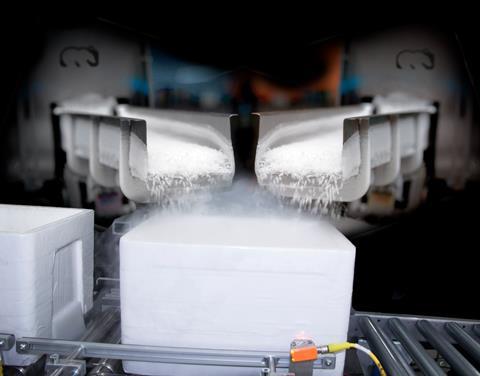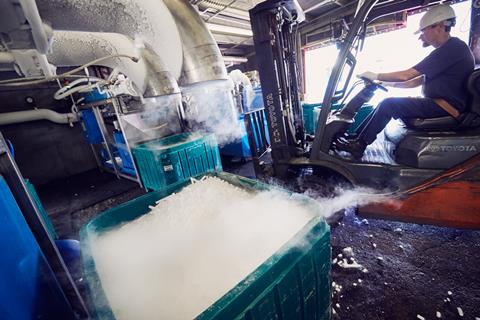
Cold Jet CEO Gene Cooke says the company experienced a sudden fivefold increase in demand for its dry ice making machines, largely due to their role in the storage and distribution of coronavirus (Covid-19) vaccines.
Dry ice – solid form of carbon dioxide (CO2) – has never been so hot for some businesses which are scrambling to keep up with a demand for product and equipment driven by the storage and distribution needs of the vaccine, as well as the growing trend for food home delivery.
Cold Jet, which has its global headquarters in Ohio, US, has seen its equipment utilised by the likes of vaccine manufacturer Pfizer-BioNTech as well as logistics companies such as UPS, DHL and FedEx.
“It went from 0mph to 60mph overnight,” Gene Cooke told gasworld US’s April issue.
“Unilaterally, we have not known demand like this. We went from little or no knowledge of Covid early in 2020 to a full-out sprint when Pfizer-BioNTech decided on a strategy for their vaccine and knowing that it needed ultracold temperature to retain its integrity. In calendar 2020 we had a fivefold increase in our dry ice manufacturing business segment.”
Cold Jet machines are now producing dry ice at all points in the vaccine distribution cold chain, from the packaging lines at pharmaceutical companies, to distribution centres at global logistics companies. Cooke explains in the interview how Cold Jet has managed to keep pace with a sudden demand for its products.

US dry ice distributors have also dealt with a surge in demand in recent months during the rollout of the vaccine.
Acme Dry Ice, based in Massachusetts, has put two new trucks on the road and hired outside drivers and trucks when necessary, as it delivers about 100,000 pounds of dry ice a day.
Brad Dunn, vice-president of Cee Kay Supply, an independent supplier of compressed gases and equipment in the Midwest, told gasworld, “We are experiencing two segments of demand – small end-users, which are typically rural or local hospital networks purchasing around 200 lbs of dry ice a week, and large medical transportation and logistics companies that are distributing truckload quantities of dry ice and vaccines.”
Some large US distributors, such as nexAir, have experienced another driver for dry ice demand. During the early days of lockdown last year, home delivery of perishable foods became a growing trend and is still driving dry ice demand.
“Right now, the vaccine related demand is relatively small in terms of dry ice sales and volume,” Steve Atkins, Executive Vice President, Gases at Memphis, Tennessee-based nexAir, told gasworld.
“We anticipate 16% volume growth in 2021. This is primarily due to higher demand from current customers. Large increase in shipments using dry ice to refrigerate food and other items.”
Tim Koerner, who is Chief Sales and Service Officer at American Carbonation Corporation, a supplier of liquid CO2, medical grade CO2 and related equipment and services for the Mid-Atlantic states and New England, says home delivery/perishable foods is driving demand as well as the vaccine for the Massachusetts-based company.
“From June on we were probably the busiest we’ve ever been with dry ice production,” Koerner told gasworld.
“I see the demand increase more with food shippers than with the vaccine. At least that’s what we’ve seen in the Northeast.”
Safety around carbon dioxide is important amid these times of increased demand; CO2Meter and Analox contribute some timely safety advice, and explain how their devices have been employed in the vaccine rollout elsewhere in the April issue of gasworld US.
Copyright Ying Jing© 京ICP备19059098号-5  京公网安备 11011302005839号 2016-2026 China International Exhibition on Gases Technology, Equipment and Application
京公网安备 11011302005839号 2016-2026 China International Exhibition on Gases Technology, Equipment and Application